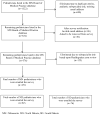Use of Rheumatology Laboratory Studies Among Primary Pediatricians
- PMID: 26755273
- PMCID: PMC5233599
- DOI: 10.1177/0009922815624902
Use of Rheumatology Laboratory Studies Among Primary Pediatricians
Abstract
Rheumatology laboratory tests are often inappropriately ordered in situations for which they are of low diagnostic utility. We surveyed pediatricians to investigate reasons for ordering these tests. The response rate was 15.3% (93/609). The most commonly ordered tests were antinuclear antibody (ANA), anti-double-stranded DNA (dsDNA) antibody, and rheumatoid factor (RF). Of the 89% (83/93) who ordered an ANA, 86% ordered it for correct/possibly correct reasons; of the 73% (68/93) who ordered RF, 80% did so for correct/possibly correct reasons; and among the 59% (54/92) who had ordered anti-dsDNA antibody, 34% ordered it for correct reasons. A positive relationship was seen between years since residency completion and correct use of ANA. However, positive associations were not seen between measures of pediatric rheumatology experience and correct use of other tests. Interventions are needed to improve pediatricians' utilization of rheumatology tests.
Keywords: HLA-B27; antinuclear antibody; cyclic citrullinated peptide; double-stranded DNA; laboratory test; pediatric rheumatology; pediatrician; primary care; referral; rheumatoid factor.
Conflict of interest statement
Conflicts of Interest: The authors report no conflicts of interest regarding this research. The authors report no financial support or financial interest regarding this research.
Figures
References
-
- Rimes KA, Goodman R, Hotopf M, Wessely S, Meltzer H, Chalder T. Incidence, prognosis, and risk factors for fatigue and chronic fatigue syndrome in adolescents: A prospective community study. Pediatrics. 2007;119(3):e603–9. 119/3/E603 [pii] - PubMed
-
- Allen RC, Dewez P, Stuart L, Gatenby PA, Sturgess A. Antinuclear antibodies using HEp-2 cells in normal children and in children with common infections. J Paediatr Child Health. 1991;27(1):39–42. - PubMed
-
- Hilario MO, Len CA, Roja SC, Terreri MT, Almeida G, Andrade LE. Frequency of antinuclear antibodies in healthy children and adolescents. Clin Pediatr (Phila) 2004;43(7):637–642. - PubMed
MeSH terms
Grants and funding
LinkOut - more resources
Full Text Sources
Other Literature Sources
Medical
Research Materials




